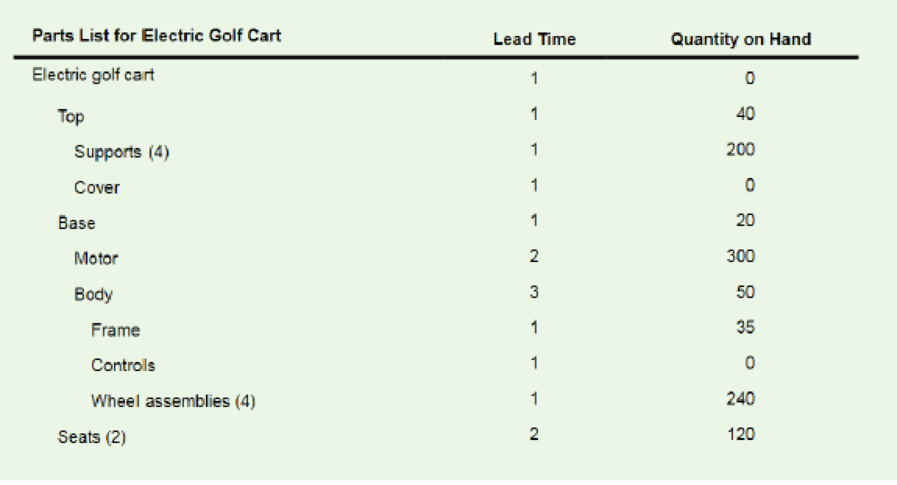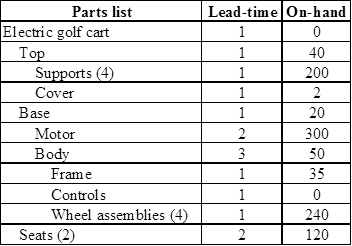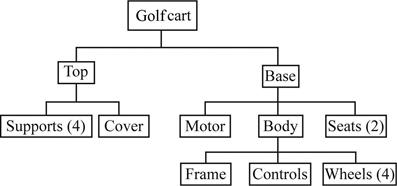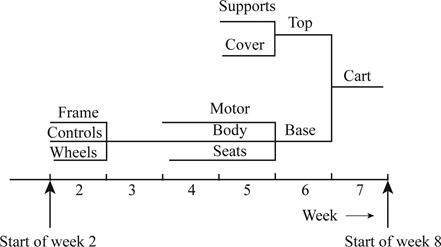
Concept explainers
A firm that produces electric golf carts has just received an order for 200 carts, which must be ready for delivery at the start of week 8. Information concerning the product structure, lead times, and quantities on hand is shown in the following table. Use this information to do each of the following:
a. Construct a product tree.
b. Construct an assembly time chart.
c. Develop a material requirements plan that will provide 200 golf carts by week 8 assuming lot-for-lot ordering.

a)
To construct: A product tree
Introduction: Materials Requirement Planning (MRP) is the planning or scheduling system, which can be used in the manufacturing process. It is used to plan the number of items required to produce one unit of finished goods (end item).
Explanation of Solution
Given information:

Construct a product tree:

b)
To construct: An assembly time chart
Introduction: Materials Requirement Planning (MRP) is the planning or scheduling system, which can be used in the manufacturing process. It is used to plan the number of items required to produce one unit of finished goods (end item).
Explanation of Solution
Given information:

Construct an assembly time chart:

c)
To prepare: Materials Requirement planning using the provided information.
Introduction: Materials Requirement Planning (MRP) is the planning or scheduling system, which can be used in the manufacturing process. It is used to plan the number of items required to produce one unit of finished goods (end item).
Explanation of Solution
Given information:
The company needs to provide 200 golf carts by week 8.

Develop a material requirement planning for golf cart:

- It is given that the company needs to provide 200 golf carts by week 8.
- Beginning inventory is 0 units.
- Net requirement can be calculated by subtracting the projected on-hand from the gross requirement. Hence, the net requirement is 200 units in week 8 (200-0).
- Planned order release is the order given by the company and planned order receipts is the order received by the firm.
- Lead-time is given as 1 week. Company requires 200 units in the beginning of Week 8. Hence, they need to order for 200 units (as the lot size is lot-for-lot) on previous week (as the lead-time is 1 week). Thus, company need to order the required units in week 7.
Develop a material requirement planning for top:

- Golf cart is the parent for top. Hence, the planned order release of the golf cart would be the gross requirement of the top. As number of units required is 1 for top, the planned order release row of golf cart should be multiplied with 1 to attain the gross requirement column of top.
- Beginning inventory is 40 units.
- Net requirement can be calculated by subtracting the projected on-hand from the gross requirement. Hence, the net requirement is 160 units in week 7 (200-40).
- Planned order release is the order given by the company and planned order receipts is the order received by the firm.
- Lead-time is given as 1 week. Company requires 160 units in the beginning of Week 7. Hence, they need to order for 160 units (as the lot size is lot-for-lot) on previous week (as the lead-time is 1 week). Thus, company need to order the required units in week 6.
- Projected on hand inventory for week 8 is 0 units. Calculation is as follows:
Develop a material requirement planning for supports (4):

- Top is the parent for supports. Hence, the planned order release of the top would be the gross requirement of the supports. As number of units required is 4 for supports, the planned order release row of top should be multiplied with 4 to attain the gross requirement column of support.
- Beginning inventory is 200 units.
- Net requirement can be calculated by subtracting the projected on-hand from the gross requirement. Hence, the net requirement is 440 units in week 6 (640-200).
- Planned order release is the order given by the company and planned order receipts is the order received by the firm.
- Lead-time is given as 1 week. Company requires 440 units in the beginning of Week 6. Hence, they need to order for 440 units (as the lot size is lot-for-lot) on previous week (as the lead-time is 1 week). Thus, company need to order the required units in week 5.
- Projected on hand inventory for week 7 is 0 units. Calculation is as follows:
Develop a material requirement planning for cover:

- Top is the parent for cover. Hence, the planned order release of the top would be the gross requirement of the cover. As number of units required is 1 for cover, the planned order release row of top should be multiplied with 1 to attain the gross requirement column of cover.
- Beginning inventory is 0 units.
- Net requirement can be calculated by subtracting the projected on-hand from the gross requirement. Hence, the net requirement is 160 units in week 6 (160-0).
- Planned order release is the order given by the company and planned order receipts is the order received by the firm.
- Lead-time is given as 1 week. Company requires 160 units in the beginning of Week 6. Hence, they need to order for 160 units (as the lot size is lot-for-lot) on previous week (as the lead-time is 1 week). Thus, company need to order the required units in week 5.
Develop a material requirement planning for base:

- Golf cart is the parent for base. Hence, the planned order release of the golf cart would be the gross requirement of the base. As number of units required is 1 for base, the planned order release row of golf cart should be multiplied with 1 to attain the gross requirement column of base.
- Beginning inventory is 20 units.
- Net requirement can be calculated by subtracting the projected on-hand from the gross requirement. Hence, the net requirement is 180 units in week 7 (200-20).
- Planned order release is the order given by the company and planned order receipts is the order received by the firm.
- Lead-time is given as 1 week. Company requires 180 units in the beginning of Week 7. Hence, they need to order for 180 units (as the lot size is lot-for-lot) on previous week (as the lead-time is 1 week). Thus, company need to order the required units in week 6.
- Projected on hand inventory for week 8 is 0 units. Calculation is as follows:
Develop a material requirement planning for motor:

- Base is the parent for motor. Hence, the planned order release of the base would be the gross requirement of the motor. As number of units required is 1 for motor, the planned order release row of base should be multiplied with 1 to attain the gross requirement column of motor.
- Beginning inventory is 300 units.
- Gross requirement for week 6 is 180 units. As the beginning inventory is sufficient to satisfy the demand, there is no necessary to place an order.
- Projected on hand inventory for week 7 is 120 units. Calculation is as follows:
Develop a material requirement planning for body:

- Base is the parent for body. Hence, the planned order release of the base would be the gross requirement of the body. As number of units required is 1 for body, the planned order release row of base should be multiplied with 1 to attain the gross requirement column of body.
- Beginning inventory is 50 units.
- Net requirement can be calculated by subtracting the projected on-hand from the gross requirement. Hence, the net requirement is 130 units in week 6 (180-50).
- Planned order release is the order given by the company and planned order receipts is the order received by the firm.
- Lead-time is given as 3 weeks. Company requires 130 units in the beginning of Week 6. Hence, they need to order for 130 units (as the lot size is lot-for-lot) before three weeks (as the lead-time is 3 weeks). Thus, company need to order the required units in week 3.
- Projected on hand inventory for week 7 is 0 units. Calculation is as follows:
Develop a material requirement planning for seats (2):

- Base is the parent for seats. Hence, the planned order release of the base would be the gross requirement of the seats. As number of units required is 1 for seats, the planned order release row of base should be multiplied with 1 to attain the gross requirement column of seats.
- Beginning inventory is 120 units.
- Net requirement can be calculated by subtracting the projected on-hand from the gross requirement. Hence, the net requirement is 240 units in week 6 (360-120).
- Planned order release is the order given by the company and planned order receipts is the order received by the firm.
- Lead-time is given as 2 weeks. Company requires 240 units in the beginning of Week 6. Hence, they need to order for 240 units (as the lot size is lot-for-lot) before two weeks (as the lead-time is 2 weeks). Thus, company need to order the required units in week 4.
- Projected on hand inventory for week 7 is 0 units. Calculation is as follows:
Develop a material requirement planning for frame:

- Body is the parent for frame. Hence, the planned order release of the body would be the gross requirement of the frame. As number of units required is 1 for frame, the planned order release row of body should be multiplied with 1 to attain the gross requirement column of frame.
- Beginning inventory is 35 units.
- Net requirement can be calculated by subtracting the projected on-hand from the gross requirement. Hence, the net requirement is 95 units in week 3 (130-35).
- Planned order release is the order given by the company and planned order receipts is the order received by the firm.
- Lead-time is given as 1 week. Company requires 95 units in the beginning of Week 3. Hence, they need to order for 95 units (as the lot size is lot-for-lot) on previous week (as the lead-time is 1 week). Thus, company need to order the required units in week 2.
- Projected on hand inventory for week 4 is 0 units. Calculation is as follows:
Develop a material requirement planning for controls:

- Body is the parent for controls. Hence, the planned order release of the body would be the gross requirement of the controls. As number of units required is 1 for controls, the planned order release row of body should be multiplied with 1 to attain the gross requirement column of controls.
- Beginning inventory is 0 units.
- Net requirement can be calculated by subtracting the projected on-hand from the gross requirement. Hence, the net requirement is 130 units in week 3 (130-0).
- Planned order release is the order given by the company and planned order receipts is the order received by the firm.
- Lead-time is given as 1 week. Company requires 130 units in the beginning of Week 3. Hence, they need to order for 130 units (as the lot size is lot-for-lot) on previous week (as the lead-time is 1 week). Thus, company need to order the required units in week 2.
Develop a material requirement planning for wheel assemblies (4):

- Body is the parent for wheel assemblies. Hence, the planned order release of the body would be the gross requirement of the wheel assemblies. As number of units required is 4 for wheel assemblies, the planned order release row of body should be multiplied with 4 to attain the gross requirement column of wheel assemblies.
- Beginning inventory is 240 units.
- Net requirement can be calculated by subtracting the projected on-hand from the gross requirement. Hence, the net requirement is 280 units in week 3 (520-240).
- Planned order release is the order given by the company and planned order receipts is the order received by the firm.
- Lead-time is given as 1 week. Company requires 280 units in the beginning of Week 3. Hence, they need to order for 280 units (as the lot size is lot-for-lot) on previous week (as the lead-time is 1 week). Thus, company need to order the required units in week 2.
- Projected on hand inventory for week 4 is 0 units. Calculation is as follows:
Want to see more full solutions like this?
Chapter 12 Solutions
EBK OPERATIONS MANAGEMENT
Additional Business Textbook Solutions
Financial Accounting: Tools for Business Decision Making, 8th Edition
Horngren's Accounting (12th Edition)
Principles of Microeconomics (MindTap Course List)
Essentials of MIS (13th Edition)
Horngren's Cost Accounting: A Managerial Emphasis (16th Edition)
Intermediate Accounting (2nd Edition)
- Prepare a master schedule given this information: The forecast for each week of an eight-week schedule is 60 units. The MPS rule is to schedule production if the projected on-hand Inventory would be negative without it. Customer orders (committed) are as follows: Week Customer Orders 1 2 36 28 4 1 Use a production lot size of 85 units and no beginning inventory. Note: In the ATP row, enter a value of 0 (zero) in any periods where ATP should not be calculated. Leave no cells blank - be certain to enter "0" wherever required. June July 1 2 3 4 5 8 7 8 Forecast 60 60 60 60 60 60 60 60 Customer Orders 38 28 4 1 0 0 0 0 Projected On-Hand Inventory MPS ATParrow_forwardSales of tablet computers at Marika Gonzalez's electronics store in Washington, D.C., over the past 10 weeks are shown in the table below: Week 1 2 3 4 5 6 7 8 9 10 Demand 21 21 27 38 25 30 35 24 25 30 a) The forecast for weeks 2 through 10 using exponential smoothing with a = 0.50 and a week 1 initial forecast of 21.0 are (round your responses to two decimal places): Week 1 2 3 4 5 6 7 8 9 10 Demand 21 21 27 38 25 30 35 24 25 30 Forecast 21.0 21 21 24 31 28 29 32 28 26.50 b) For the forecast developed using exponential smoothing (a = 0.50 and initial forecast 21.0), the MAD = |||||sales (round your response to two decimal places).arrow_forwardSales of tablet computers at Marika Gonzalez's electronics store in Washington, D.C., over the past 10 weeks are shown in the table below: Week Demand 1 2 3 4 5 6 7 8 9 10 21 21 27 38 25 30 35 24 25 30 a) The forecast for weeks 2 through 10 using exponential smoothing with a = 0.50 and a week 1 initial forecast of 21.0 are (round your responses to two decimal places): Week 1 2 3 4 5 Demand 21 21 27 38 Forecast 21.0 ☐ G ☐ ☐ 6 7 25 30 35 ∞ ☐ 8 9 10 24 25 30arrow_forward
- Each machine costs $3 Million. Building the room with all its attendant safety protection and other ancillary costs increases the spending by an additional $2.0 million dollars per MRI suite. Each machine can perform 2000 scans per year. Each reading of an MRI scan by a radiologist, along with other per-scan-related costs, is $500 per scan. The machine will last five years. Don’t worry about discount rates for this problem Graph the total costs over 5 years as a function of sales for 0-3000 patients annually. Hint: you may need to add a second MRI at some point. Suppose that you want to make a profit of $500 per scan at a target volume of 1000 patients per year, and you purchase only one machine. Superimpose the total revenue curve on top of the total cost curve in (1).arrow_forwardI need the answer to requirement C.arrow_forwardImagine you are Susan Kim and are faced with a difficult choice to either follow the orders she was given, or refusing to do so. Using each lens determine what the ethical response would be. Suppot your answer with materials from readings and lectures. For example, using Universalism what would the ethical response be? Do the same for all four lenses.arrow_forward
- Answer all these questions, selecting any company of your choice. Choose a specific type of food company. Select a specific product. Develop all the inputs that are part of the process. Develop the transformation process in a graphic (diagram, etc.). Develop all the outputs or finished products that are part of the process. Describe all the processes involved in one line of production in any manufacturing facility. Also describing how good management is the center of any part of a production company.arrow_forwardUsing exponential smoothing with α =0.2, forecast the demand for The initial forecast for January is 2000 tons. Calculate the capacity utilization for June, July and Discuss the implications of underutilized or over utilized capacity for Green Harvestarrow_forwardIn organizational development when results are improving but relationships are declining, what leadership style is appropriate? directing delegating supporting coachingarrow_forward
- What is the first thing a leader should do when moving through a cultural change? conduct an assessment comparing the practices to other high-performing organizations learn about the current organizational culture continue to monitor key metrics define expectationsarrow_forwardThe third change leadership strategy, Collaborate on Implementation, is designed to address what type of concerns? impact concerns personal concerns refinement concerns collaboration concernsarrow_forwardIf team members are concerned with specifics such as their tasks, contingency plans, resources, and timeline, what concerns do they have? implementation concerns impact concerns refinement concerns personal concernsarrow_forward
 Practical Management ScienceOperations ManagementISBN:9781337406659Author:WINSTON, Wayne L.Publisher:Cengage,MarketingMarketingISBN:9780357033791Author:Pride, William MPublisher:South Western Educational Publishing
Practical Management ScienceOperations ManagementISBN:9781337406659Author:WINSTON, Wayne L.Publisher:Cengage,MarketingMarketingISBN:9780357033791Author:Pride, William MPublisher:South Western Educational Publishing Purchasing and Supply Chain ManagementOperations ManagementISBN:9781285869681Author:Robert M. Monczka, Robert B. Handfield, Larry C. Giunipero, James L. PattersonPublisher:Cengage Learning
Purchasing and Supply Chain ManagementOperations ManagementISBN:9781285869681Author:Robert M. Monczka, Robert B. Handfield, Larry C. Giunipero, James L. PattersonPublisher:Cengage Learning Contemporary MarketingMarketingISBN:9780357033777Author:Louis E. Boone, David L. KurtzPublisher:Cengage Learning
Contemporary MarketingMarketingISBN:9780357033777Author:Louis E. Boone, David L. KurtzPublisher:Cengage Learning





